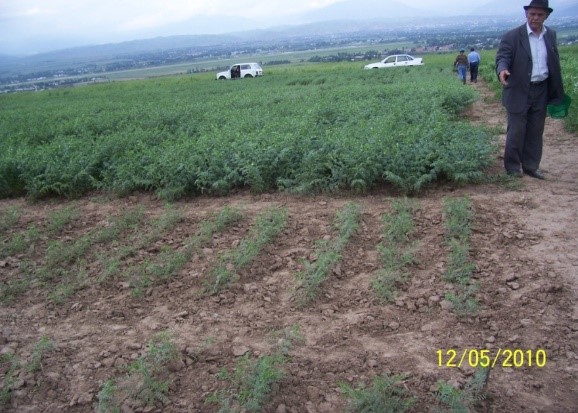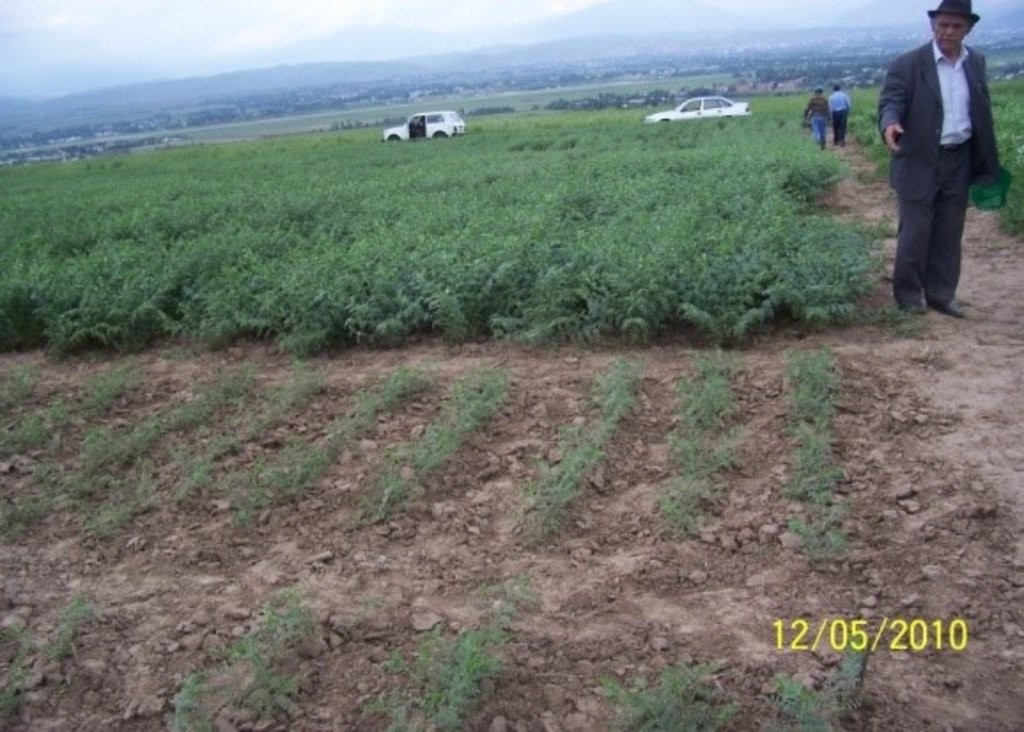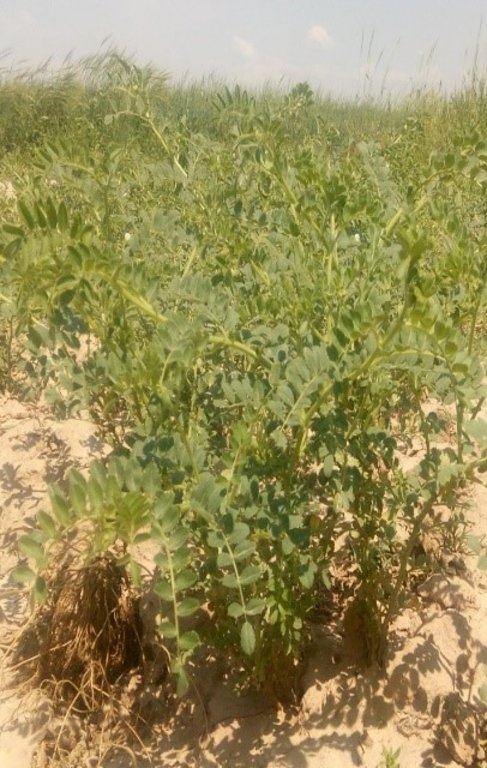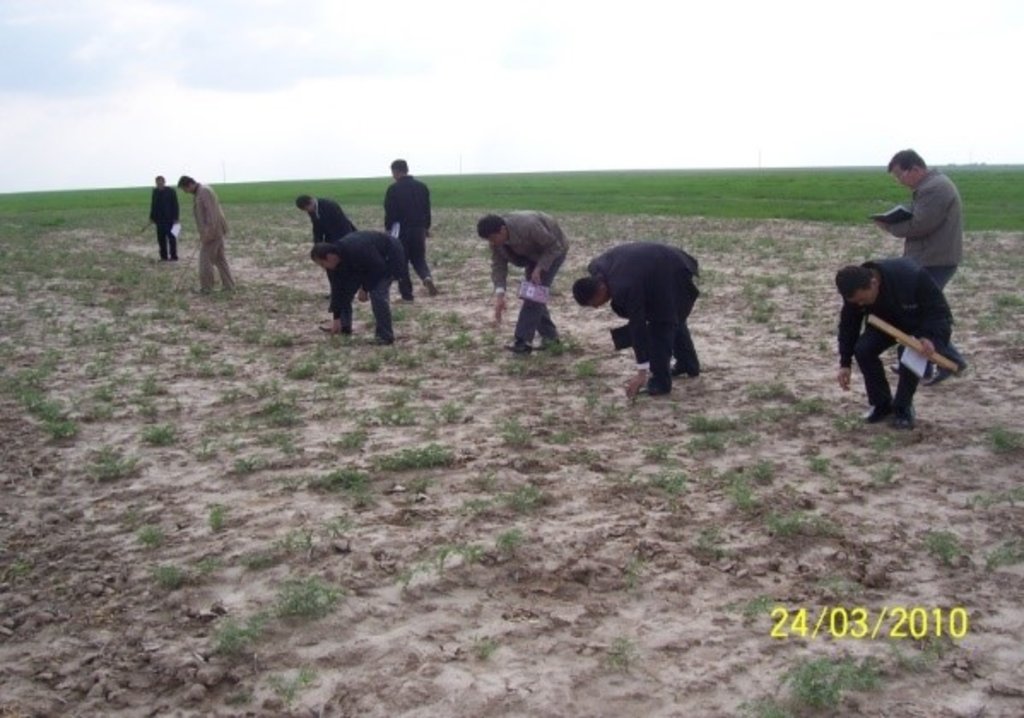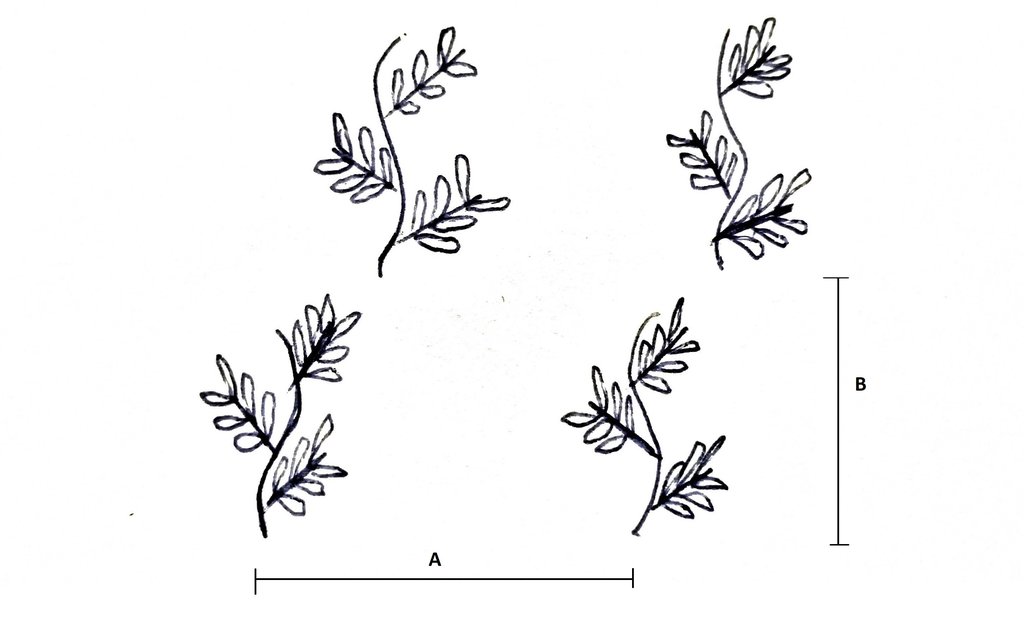Winter Chickpea Planting in Cold Dry Areas [Uzbekistan]
- Creation:
- Update:
- Compiler: Joren Verbist
- Editor: Hayot Ibrakhimov
- Reviewers: William Critchley, Rima Mekdaschi Studer
technologies_5916 - Uzbekistan
View sections
Expand all Collapse all1. General information
1.2 Contact details of resource persons and institutions involved in the assessment and documentation of the Technology
Key resource person(s)
Senior Scientist:
Sharma Ram
International Center of Agriculture Research in the Dry Areas (ICARDA)
Uzbekistan
Senior Scientist:
Akrammkhanov Akmal
International Center of Agriculture Research in the Dry Areas (ICARDA)
Uzbekistan
Research Associate:
Amanov Shukhrat
International Center of Agriculture Research in the Dry Areas (ICARDA)
Uzbekistan
Name of project which facilitated the documentation/ evaluation of the Technology (if relevant)
ICARDA Institutional Knowledge Management InitiativeName of the institution(s) which facilitated the documentation/ evaluation of the Technology (if relevant)
International Center for Agricultural Research in the Dry Areas (ICARDA) - Lebanon1.3 Conditions regarding the use of data documented through WOCAT
The compiler and key resource person(s) accept the conditions regarding the use of data documented through WOCAT:
Ja
1.4 Declaration on sustainability of the described Technology
Is the Technology described here problematic with regard to land degradation, so that it cannot be declared a sustainable land management technology?
Nee
2. Description of the SLM Technology
2.1 Short description of the Technology
Definition of the Technology:
The use of cold tolerant chickpeas, sown in autumn, significantly benefits farmers by realizing higher profits thanks to smaller amounts of fertilizers required, increased yields, and a better market price.
2.2 Detailed description of the Technology
Description:
Uzbekistan and Tajikistan have an extreme, unstable and uncertain environment. A large part of Uzbekistan also falls under a cold winter desert regime with extremely cold winters, hot summers and a dry climate. These conditions are being exacerbated because of climate change. The temperatures vary between (approximately) -20 and 40 degrees Celsius for winter and summer respectively. In addition to these harsh temperatures, there is little precipitation in the rainfed landscapes, with average annual rainfall varying between 100 and 200 millimetres. The extreme environment results in difficult conditions for agricultural production in rainfed areas, because most plants are not able to grow during winter due to low temperatures and non-optimally used, scarce, rainfall during that period. In addition, land is degraded due to the continuous mono-cropping of cereals. This has led to the depletion of soil organic matter and soil nutrients and will lead to a soil unsuitable for crop cultivation.
The International Centre of Agriculture Research in Dry Areas (ICARDA) recognized this problem and conducted research into improved varieties that can cope with the extreme temperatures in winter. These improved varieties were then shared with national partners, who evaluated them. Chickpeas are considered to be a promising crop, because firstly, they are leguminous with a high protein content. Legumes have the benefit of fixing atmospheric nitrogen into the soil. This is important since the soil is becoming exhausted due to continuous cultivation of cereals. Secondly, by planting chickpeas in autumn, the rainfall that falls in winter can be efficiently used. Thirdly, chickpeas planted in autumn, complete their life cycle before the heatwaves in summer and thus can be harvested easily.
Furthermore, farmers benefit because the chickpeas increase net income, compared to cereal production. This is thanks to the higher rainfall efficiency, improved soil conditions and avoided heatwaves. Originally, farmers planted regular chickpeas in the early spring, missing valuable winter rain. They were forced to plant in this period because the traditional chickpea varieties would not survive low winter temperatures. Additionally, sowing was often postponed because the soil was too wet due to snow melt. Improved chickpeas, sown in autumn, yield up to 50% more than the spring-sown chickpeas - reaching a yield up to two tonnes per hectare. Besides economic profitability, soil health has improved due to nitrogen fixation. In turn, this translates into higher profits because less nitrogen fertilizer is required.
The fields are prepared in October, the chickpeas are sown and fertilizer is applied. In March, the fields are weeded. Finally, the winter chickpeas are harvested, threshed and cleaned between May and June. In this documentation, manual weeding and manual harvesting are described because on many small farms and households most activities rely on family labour. However, winter chickpeas may also be harvested and weeded by machine, reducing costs.
Information and data presented is partly made available through the project Collaborative Research Project on Sustainable Soil Management to Enhance Agricultural Productivity in Central Asia funded by IFPRI within the framework of Russian Federation funding to CGIAR.
2.3 Photos of the Technology
2.5 Country/ region/ locations where the Technology has been applied and which are covered by this assessment
Country:
Uzbekistan
Region/ State/ Province:
Tajikistan
Specify the spread of the Technology:
- evenly spread over an area
If the Technology is evenly spread over an area, specify area covered (in km2):
2.0
Is/are the technology site(s) located in a permanently protected area?
Nee
Map
×2.6 Date of implementation
If precise year is not known, indicate approximate date:
- 10-50 years ago
2.7 Introduction of the Technology
Specify how the Technology was introduced:
- during experiments/ research
- through projects/ external interventions
3. Classification of the SLM Technology
3.1 Main purpose(s) of the Technology
- improve production
- reduce, prevent, restore land degradation
- adapt to climate change/ extremes and its impacts
- create beneficial economic impact
3.2 Current land use type(s) where the Technology is applied

Cropland
- Annual cropping
Annual cropping - Specify crops:
- legumes and pulses - other
Number of growing seasons per year:
- 1
Is intercropping practiced?
Nee
Is crop rotation practiced?
Nee
3.3 Has land use changed due to the implementation of the Technology?
Has land use changed due to the implementation of the Technology?
- No (Continue with question 3.4)
3.4 Water supply
Water supply for the land on which the Technology is applied:
- rainfed
3.5 SLM group to which the Technology belongs
- improved ground/ vegetation cover
- improved plant varieties/ animal breeds
3.6 SLM measures comprising the Technology

agronomic measures
- A3: Soil surface treatment
- A5: Seed management, improved varieties

management measures
- M4: Major change in timing of activities
3.7 Main types of land degradation addressed by the Technology

soil erosion by water
- Wt: loss of topsoil/ surface erosion
- Wg: gully erosion/ gullying

chemical soil deterioration
- Cn: fertility decline and reduced organic matter content (not caused by erosion)

biological degradation
- Bl: loss of soil life
3.8 Prevention, reduction, or restoration of land degradation
Specify the goal of the Technology with regard to land degradation:
- reduce land degradation
- restore/ rehabilitate severely degraded land
4. Technical specifications, implementation activities, inputs, and costs
4.1 Technical drawing of the Technology
Technical specifications (related to technical drawing):
The plant density is 350,000 to 500,000 plants per hectare, following this spacing:
Plant interspace in row (A) = 7 to 10 centimeters
Row interspace (B) = 30 to 45 centimeters
Author:
Joren Verbist
Date:
12/07/2021
4.2 General information regarding the calculation of inputs and costs
Specify how costs and inputs were calculated:
- per Technology area
Indicate size and area unit:
1 hectare
Specify currency used for cost calculations:
- USD
Indicate average wage cost of hired labour per day:
10
4.5 Maintenance/ recurrent activities
| Activity | Timing/ frequency | |
|---|---|---|
| 1. | Seed Procurement | September - October |
| 2. | Land Preparation | October |
| 3. | Planting | October |
| 4. | Fertilization | October |
| 5. | Weed Control | March |
| 6. | Harvesting, Threshing and Cleaning | May-June |
4.6 Costs and inputs needed for maintenance/ recurrent activities (per year)
| Specify input | Unit | Quantity | Costs per Unit | Total costs per input | % of costs borne by land users | |
|---|---|---|---|---|---|---|
| Labour | Weeding | Labour-Day | 3.8 | 10.0 | 38.0 | 100.0 |
| Labour | Harvesting | Labour-Day | 3.8 | 10.0 | 38.0 | 100.0 |
| Equipment | Plow | Machine-Hour | 1.0 | 14.0 | 14.0 | 100.0 |
| Equipment | Harrow | Machine-Hour | 1.0 | 14.0 | 14.0 | 100.0 |
| Equipment | Seeder | Machine-Hour | 1.0 | 14.0 | 14.0 | 100.0 |
| Equipment | Thresher | Machine-Hour | 2.0 | 21.0 | 42.0 | 100.0 |
| Equipment | Cleaner | Machine-Hour | 1.0 | 19.0 | 19.0 | 100.0 |
| Equipment | Cultivator | Machine-Hour | 1.5 | 7.0 | 10.5 | 100.0 |
| Plant material | Chickpea Seeds | Kilogram | 60.0 | 1.9 | 114.0 | 100.0 |
| Fertilizers and biocides | Ammophos | Kilogram | 100.0 | 0.24 | 24.0 | 100.0 |
| Fertilizers and biocides | Urea | Kilogram | 100.0 | 0.19 | 19.0 | 100.0 |
| Other | Fuel | Liter | 50.0 | 0.67 | 33.5 | 100.0 |
| Other | Transportation | Total | 1.0 | 38.0 | 38.0 | 100.0 |
| Total costs for maintenance of the Technology | 418.0 | |||||
| Total costs for maintenance of the Technology in USD | 418.0 | |||||
4.7 Most important factors affecting the costs
Describe the most determinate factors affecting the costs:
The cost of the chickpea seeds significantly contributes to the costs.
5. Natural and human environment
5.1 Climate
Annual rainfall
- < 250 mm
- 251-500 mm
- 501-750 mm
- 751-1,000 mm
- 1,001-1,500 mm
- 1,501-2,000 mm
- 2,001-3,000 mm
- 3,001-4,000 mm
- > 4,000 mm
Specifications/ comments on rainfall:
In the summer (June - September) there is little rainfall (0-10 average mm / month). In the remaining months, the average monthly precipitation is between 10 and 20 mm.
Agro-climatic zone
- semi-arid
- arid
5.2 Topography
Slopes on average:
- flat (0-2%)
- gentle (3-5%)
- moderate (6-10%)
- rolling (11-15%)
- hilly (16-30%)
- steep (31-60%)
- very steep (>60%)
Landforms:
- plateau/plains
- ridges
- mountain slopes
- hill slopes
- footslopes
- valley floors
Altitudinal zone:
- 0-100 m a.s.l.
- 101-500 m a.s.l.
- 501-1,000 m a.s.l.
- 1,001-1,500 m a.s.l.
- 1,501-2,000 m a.s.l.
- 2,001-2,500 m a.s.l.
- 2,501-3,000 m a.s.l.
- 3,001-4,000 m a.s.l.
- > 4,000 m a.s.l.
Indicate if the Technology is specifically applied in:
- not relevant
5.3 Soils
Soil depth on average:
- very shallow (0-20 cm)
- shallow (21-50 cm)
- moderately deep (51-80 cm)
- deep (81-120 cm)
- very deep (> 120 cm)
Soil texture (topsoil):
- medium (loamy, silty)
Soil texture (> 20 cm below surface):
- medium (loamy, silty)
Topsoil organic matter:
- low (<1%)
5.4 Water availability and quality
Ground water table:
5-50 m
Availability of surface water:
poor/ none
Water quality (untreated):
for agricultural use only (irrigation)
Water quality refers to:
ground water
Is water salinity a problem?
Nee
Is flooding of the area occurring?
Nee
5.5 Biodiversity
Species diversity:
- low
Habitat diversity:
- low
5.6 Characteristics of land users applying the Technology
Sedentary or nomadic:
- Sedentary
Market orientation of production system:
- mixed (subsistence/ commercial)
Off-farm income:
- 10-50% of all income
Relative level of wealth:
- poor
Individuals or groups:
- individual/ household
Level of mechanization:
- mechanized/ motorized
Gender:
- women
- men
Age of land users:
- youth
- middle-aged
- elderly
5.7 Average area of land used by land users applying the Technology
- < 0.5 ha
- 0.5-1 ha
- 1-2 ha
- 2-5 ha
- 5-15 ha
- 15-50 ha
- 50-100 ha
- 100-500 ha
- 500-1,000 ha
- 1,000-10,000 ha
- > 10,000 ha
Is this considered small-, medium- or large-scale (referring to local context)?
- small-scale
5.8 Land ownership, land use rights, and water use rights
Land ownership:
- individual, titled
Land use rights:
- individual
Water use rights:
- individual
Are land use rights based on a traditional legal system?
Ja
5.9 Access to services and infrastructure
health:
- poor
- moderate
- good
education:
- poor
- moderate
- good
technical assistance:
- poor
- moderate
- good
employment (e.g. off-farm):
- poor
- moderate
- good
markets:
- poor
- moderate
- good
energy:
- poor
- moderate
- good
roads and transport:
- poor
- moderate
- good
drinking water and sanitation:
- poor
- moderate
- good
financial services:
- poor
- moderate
- good
6. Impacts and concluding statements
6.1 On-site impacts the Technology has shown
Socio-economic impacts
Production
crop production
crop quality
risk of production failure
Income and costs
expenses on agricultural inputs
farm income
Ecological impacts
Soil
soil cover
nutrient cycling/ recharge
soil organic matter/ below ground C
6.2 Off-site impacts the Technology has shown
impact of greenhouse gases
6.3 Exposure and sensitivity of the Technology to gradual climate change and climate-related extremes/ disasters (as perceived by land users)
Gradual climate change
Gradual climate change
| Season | increase or decrease | How does the Technology cope with it? | |
|---|---|---|---|
| seasonal temperature | winter | decrease | very well |
| annual rainfall | decrease | not well | |
| seasonal rainfall | winter | increase | very well |
Climate-related extremes (disasters)
Climatological disasters
| How does the Technology cope with it? | |
|---|---|
| extreme winter conditions | very well |
6.4 Cost-benefit analysis
How do the benefits compare with the establishment costs (from land users’ perspective)?
Short-term returns:
positive
Long-term returns:
very positive
How do the benefits compare with the maintenance/ recurrent costs (from land users' perspective)?
Short-term returns:
positive
Long-term returns:
very positive
6.5 Adoption of the Technology
- > 50%
Of all those who have adopted the Technology, how many did so spontaneously, i.e. without receiving any material incentives/ payments?
- 91-100%
6.6 Adaptation
Has the Technology been modified recently to adapt to changing conditions?
Nee
6.7 Strengths/ advantages/ opportunities of the Technology
| Strengths/ advantages/ opportunities in the land user’s view |
|---|
| Increased income because of higher yield |
| Decreased costs because of less required fertilizer |
| Improved soil conditions because of nitrogen fixation. |
| Strengths/ advantages/ opportunities in the compiler’s or other key resource person’s view |
|---|
| Improved soil conditions |
| Higher rain-water efficiency |
6.8 Weaknesses/ disadvantages/ risks of the Technology and ways of overcoming them
| Weaknesses/ disadvantages/ risks in the land user’s view | How can they be overcome? |
|---|---|
| Decreased production of cereals hence increased relative demand for cereals | Research is needed into the possibility of combining chickpeas and cereals e.g., intercropping or crop rotation. |
| Costs of seeds of improved chickpea variety, however less required fertilizer and improved yield compensates for this. | More farmers producing seeds should result in lower seed costs. |
| Weaknesses/ disadvantages/ risks in the compiler’s or other key resource person’s view | How can they be overcome? |
|---|---|
| The mono-cropping of chickpeas might lead to increased risk of diseases | Research is needed into the possibility of combining chickpeas and other crops e.g., intercropping or better pest resistant varieties. |
7. References and links
7.1 Methods/ sources of information
- interviews with SLM specialists/ experts
- compilation from reports and other existing documentation
When were the data compiled (in the field)?
2021
Comments:
The documentation was carried out in 2021, starting in January.
7.2 References to available publications
Title, author, year, ISBN:
Shukhrat Amanov, Akmal Akramkhanov, Ram Sharma. (4/4/2019). Climate-resilient food legumes for higher and sustainable productivity of rain-fed crop lands in Central Asia.
Available from where? Costs?
https://hdl.handle.net/20.500.11766/9844
Title, author, year, ISBN:
Dilfuza Egamberdieva, Vyacheslav Shurigin, Subramaniam Gopalakrishnan, Ram Sharma. (20/2/2014). Growth and Symbiotic Performance of Chickpea (Cicer arietinum) Cultivars under Saline Soil Conditions. Journal of Biological and Chemical Research, 31(1), pp. 333-341.
Available from where? Costs?
https://hdl.handle.net/20.500.11766/5357
Title, author, year, ISBN:
Ram Sharma. (1/6/2020). Planting Chickpea in October Shows Promise in the Cold Winter Dessert Climate of Uzbekistan. Beirut, Lebanon: International Center for Agricultural Research in the Dry Areas (ICARDA).
Available from where? Costs?
https://hdl.handle.net/20.500.11766/11231
Links and modules
Expand all Collapse allLinks
No links
Modules
No modules


